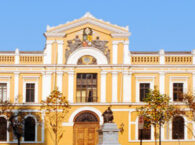Montana State University students deliver recommendations for trail improvements in Bozeman
Architecture students analyze the state of a connected parks and trails network and propose infrastructural improvements to increase accessibility and connectivity
Metrics
Community
Bozeman, MontanaUniversity
Montana State UniversityProgram
Community Engaged and Transformational Scholarship (CATS)Years
2018-2020Case Type
Project StoriesDiscipline
Landscape ArchitectureRegion
EPA Region 8, USALocated in southern Montana, the City of Bozeman is home to approximately 50,000 people. The Gallatin County seat offers a thriving arts scene, cultural festivals, farmers’ markets, and excellent outdoor recreation in nearby Paradise Valley, Yellowstone National Park, and the Gallatin Mountains. Local officials and residents value a sustainable, equitable, and participatory approach to community planning across a range of focus areas.
Citywide trail network a valuable amenity
Bozeman’s trail network allows for year-round sustainable transportation on foot or bicycle. As suburban development surges to accommodate population growth, it has become increasingly important to defend and maintain the quality, accessibility, and connectivity of these local trails and open spaces. Prior to updating its Parks, Recreation, Open Space, and Trails (PROST) plan, the Bozeman Parks and Recreation Department and the Gallatin Valley Land Trust (GVLT) needed accurate trail information and user analysis.
Student research garners insight into parks and trails
Representatives from Bozeman Parks and Recreation and GVLT partnered with the School of Architecture at Montana State University through the Community Engaged and Transformational Scholarship (CATS) initiative. Dr. Susanne Cowen challenged students in her Architecture 452: Research Methods in Architecture course to evaluate the state of local trails and determine the need for new or improved infrastructure. Focusing only on trails within city limits, students conducted open space mapping, trail user counts and surveys, and demographic analyses. They then used this data to collaboratively redesign routes and propose changes in high-traffic areas.
Wide ranging recommendations for a more walkable and bikeable city
The final report presents course research and survey results and provides data-backed recommendations for consideration by Parks and Recreation and GVLT. Student deliverables include detailed trail maps to highlight accessibility, connectivity, and way-finding gaps. Particular emphasis is placed on Bozeman’s rapidly developing Northwest quadrant.
Proposals include:
- Crosswalks and additional trail segments at key areas to close trail gaps and improve connectivity
- Planting trees along a road-adjacent trail to create an ecologically integrated pedestrian safety barrier
- Landscaped lighting to increase pedestrian visibility and accessibility
- A codified wayfinding system to help tourists and residents navigate the city on the trail network
Bozeman residents appreciate their trail amenities, as evidenced by their daily use of local trails to commute and play. Participants involved in this project delivered actionable recommendations capable of enhancing non-vehicle connectivity and open space in a developing city.


